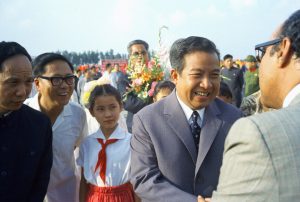FCambodia’s Disastrous Dependence on China: A History Lesson
Op-Ed: The Diplomate
Overdependence on China undermines Cambodia’s national security. We know because it’s happened before.By Chansambath BongDecember 04, 2019

In May 1965, then-Prince Norodom Sihanouk of Cambodia terminated diplomatic relations with the United States. In so doing, he altered his strict adherence of neutrality in foreign policy to align with the People’s Republic of China (PRC).
Sihanouk was in part acting in response to a derogatory article by Bernard Krisher for Newsweek that accused his mother, Queen Sisowath Kossamak, of running a bordello, along with an air raid by an American plane on a village in Kampong Cham province, which killed one teenage boy and injured a few others. Although these events may be viewed as the last straws that pushed Cambodia-U.S. ties to the breaking point, other factors — such as Pathet Lao’s victory at the Plain of Jarres in 1961, the downfall of Ngo Dinh Diem in 1963, and America’s alleged sabotaging efforts against his conference proposal — all played parts in the debacle.
Sihanouk’s decision to opt for close alignment with China had a number of implications for Cambodia’s national security. Internally, suspension of American aid in 1963 stirred contention among the rank and file of the Cambodian armed forces close to General Lon Nol and the commercial elites, both of whom had fed on U.S. largess and economic benefits since 1955.
Moreover, the halt pushed Cambodia’s aid-dependent economy into a tailspin. The nationalization of banking and trade industries created opportunities for corrupt officials to benefit from illegal rice sales at the expense of the general public, who were bearing the brunt of economic hardship.
Externally, alignment with China created both short- and long-term impacts on Cambodia’s foreign policy. For one thing, Cambodia’s alignment with China allowed Beijing to take advantage of Sihanouk’s unbalanced foreign policy. Chinese officials pressured the prince to allow Viet Cong supply lines to run through Kompong Som port up to the Ho Chi Minh trail. That turned out to be an unofficial invitation for American B-52 Stratofortress bomber runs, and Cambodia is still feeling the effects of this today.
In the short term, Sihanouk’s choice also pushed Cambodia into deeper diplomatic isolation with no friend to rely on as the decision to break off ties with the United States in 1965 came just as that the Great Proletariat Cultural Revolution was about to sweep across China. Once the Red Guards occupied the PRC’s foreign affairs ministry in mid-1966, China’s foreign policy radically shifted from Pancha Shila or the five principles of peaceful co-existence to exporting revolution abroad. Prince Sihanouk became increasingly suspicious of China’s intentions after rumors that Beijing was secretly exporting its revolutionary ideas through the Cambodian-Chinese Friendship Association spread across the country.
The last straw came when Chinese Premier Zhou Enlai, who was a target of the Red Guards at this point, openly asked Cambodia to allow the ethnic Chinese community to pledge their allegiance to Communism and Chairman Mao, a move that broke with Beijing’s long-held tradition of Pancha Shila. These developments greatly unnerved Sihanouk, who had previously expected that China would stand behind him through thick and thin without trying to impose its ideology on Cambodia.
The rapid radicalization of Chinese foreign policy made the monarch feel like he had painted himself into a corner. He had alienated the American the previous year and now it looked like the Chinese were about to flip on him as well. It would be nothing short of diplomatic suicide for Cambodia if Beijing reneged.ADVERTISEMENT
Although Sino-Cambodian relations gradually went back to normalcy in 1968, Chinese officials appeared to cross the line when, according to one account, Kang Sheng, who was a member of the Gang of Four, visited Khmer Rouge’s liberated region in 1968. This could suggest that part of the Chinese government had begun working with the Khmer Communists behind Sihanouk’s back before the 1970 coup. It’s not surprising, then, that Beijing threw its full weight behind the Khmer Rouge when it took over Kampuchea in April 1975.
Continue reading